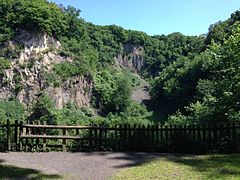Heisterbacher Talbahn
The Heisterbacher Talbahngesellschaft (HTB) was an AG that operated a narrow-gauge railway (750 mm) from the Rhine Valley to the Siebengebirge . This led from Niederdollendorf via Oberdollendorf , Heisterbach Abbey , Heisterbacherrott and Thomasberg to Grengelsbitze .
Construction began in 1889. On 22 October 1891 could (without branch lines are opened) 7,2 kilometer route; an expansion followed in 1894. In 1895, the Brölthaler Eisenbahn AG , later the Rhein-Sieg-Eisenbahn AG, which had opened up several basalt quarries in the volcanic area of the Westerwald and which HTB viewed as a competitor, leased their operation. In 1901 - according to other sources on October 8, 1903 - the HTB was acquired by the RSE and the valley railway company liquidated.
The railway was mainly used to transport products from the various quarries, the lignite from Thomasberg and the tapping of clay to the main railway line to Niederdollendorf (where a freight station was built after 1888), but above all to the loading point on the Rhine. Public passenger transport was also offered until 1930, but was then discontinued (timetables indicate a journey time of around 35 minutes for the route from Grengelsbitze to Niederdollendorf) because the Dollendorf- Oberpleis route had been taken over by buses of the Rhein-Sieg Railway since 1926 .
The passenger coaches of the Heisterbacher Talbahn later switched to Rhein-Sieg Eisenbahn AG. A historical photo from Quirrenbach with the RSE steam locomotive 52 is evidence of this.
A connection between the Heisterbacher Talbahn (750 mm) and the Rhein-Sieg Railway (785 mm) was planned. A cross connection from Heisterbacherroth (HTB) across the Siebengebirge to Herresbach / Oberpleis (RSE) would have had to be realized and the entire Heisterbach valley railway would have to be re-gauged to the gauge of the RSE. This would have enabled a mutual exchange of the wagons. Due to the complex and difficult implementation, this plan was ruined over the years.
Freight traffic, which was always the most important source of income, was stopped on the main line in 1942 and the dismantled tracks went to the eastern frontline areas. The last train on the branch lines to Römlinghoven (clay transport) and to the factories ran in 1950.
Branch lines from the main line
- Branch line from the Grengelsbitze to the loading point of the Scharfenberg quarry , length about 1.5 km.
- Branch line from the Grengelsbitze to the brown coal mine in Thomasberg in Limperichsberg .
- Branch line to the loading point at the Weilberg quarry , this route was the only one with a short tunnel.
- Branch line to the valley station of the Brocksiefen sound mine cable car .
- Branch line to the valley station of the aerial tramway of the quarry on Petersberg .
- Branch line to the two loading points at the valley stations of the two flat cable cars on the Karschberg in Römlinghoven.
- Branch line to the loading points on the Rhine.
literature
- Jean Assenmacher: memories of the Heisterbach valley railway. Circle of Heimatfreunde Niederdollendorf, Königswinter 1983.
- Carsten Gussmann, Wolfgang Clössner: The Heisterbach valley railway and industrial railways in the Siebengebirge. History, vehicles, track plans and maps. EK-Verlag, Freiburg (Breisgau) 2006, ISBN 3-88255-456-8 ( Regional Transport History 39).
- Gerd Wolff: German small and private railways. Volume 4: North Rhine-Westphalia, southern part. EK-Verlag, Freiburg (Breisgau) 1997, ISBN 3-88255-660-9 .





